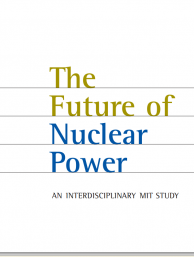
The Future of Nuclear Power

Executive Summary: Study Context
Over the next 50 years, unless patterns change dramatically, energy production and use will contribute to global warming through largescale greenhouse gas emissions — hundreds of billions of tonnes of carbon in the form of carbon dioxide. Nuclear power could be one option for reducing carbon emissions.
At present, however, this is unlikely: nuclear power faces stagnation and decline.
This study analyzes what would be required to retain nuclear power as a significant option for reducing greenhouse gas emissions and meeting growing needs for electricity supply. Our analysis is guided by a global growth scenario that would expand current worldwide nuclear generating capacity almost threefold, to 1000 billion watts, by the year 2050. Such a deployment would avoid 1.8 billion tonnes of carbon emissions annually from coal plants, about 25% of the increment in carbon emissions otherwise expected in a business-as-usual scenario. This study also recommends changes in government policy and industrial practice needed in the relatively near term to retain an option for such an outcome.
We did not analyze other options for reducing carbon emissions — renewable energy sources, carbon sequestration, and increased energy efficiency — and therefore reach no conclusions about priorities among these efforts and nuclear power. In our judgment, it would be a mistake to exclude any of these four options at this time.
- Issues:
- Infrastructure, Energy, Climate Change, Natural Resources
- Regions:
- Global, North America
- Country:
- United States
- Year Published:
- 2003
- Institution:
- Massachusetts Institute of Technology (MIT)

